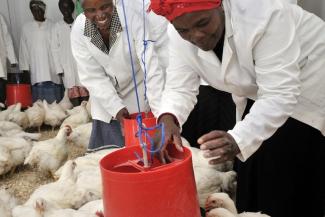EU meat exports
High development costs
 Hussein/AP/picture-alliance
Hussein/AP/picture-alliance
The EU’s policy makers on agriculture face a dilemma. If intensive livestock farming is to be profitable, it goes along with negative side effects. The undesired aspects include inappropriate husbandry and feed, nitrate pollution of groundwater, the development of antibiotic-resistant bacteria, wage dumping in abattoirs and meat scandals. Negative impacts are not limited to Europe. The EU imports vast amounts of cheap soya from South America to feed animals. Producing soya requires vast expanses of new farm land, so rainforests are destroyed and indigenous groups displaced. Next, the soil deteriorates because of the cultivation of genetically-modified crops with pesticides like glyphosate.
Europe’s intensive livestock farming leads to overproduction. Accordingly, about a quarter of German farmers’ earnings come from exports. The EU is still their biggest market, but it will probably soon reach the saturation point for livestock products. The industry is aware of this trend and knows that eastern European markets are recessive. Therefore it wants to fast-track the development of new markets in Africa. Led by Benin and South Africa, the continent has become the largest growth market for EU meat. In 2014, nearly 300,000 tonnes of chicken cuts were exported to those two African countries.
It would be simplistic to blame the EU alone for the developmental consequences of manoeuvring in the global meat market. Emerging markets themselves are embracing the model of intensive livestock farming. It took Brazil only a few years to become one of the world’s biggest meat exporters. It would have conquered the EU chicken and pork market long ago if tariffs and EU abattoir regulations had not limited Brazilian competition.
If markets were free, European livestock farmers would not stand a chance. Farmers in the remote areas of Brazil or the USA have to meet less stringent regulations. In both countries, animals are kept in numbers that would not be permitted in Germany. Today, Brazil competes along with the US in third markets that are major importers of EU chicken and pork: Saudi Arabia (only chicken), China, Africa Ukraine and, until recently, Russia.
When the EU started to export meat in large quantities in the late 1990s, its products were only competitive in overseas markets (with the exception of South Africa) because they were subsidised by up to 30 cents a kilo. Today, such subsidies are no longer needed. The spread of intensive livestock farming in the EU has lowered costs. In terms of prices, EU farmers have become competitive with those in the USA, Brazil or Thailand.
Nigeria, for example
EU farmers do not like to be called polluters or animal abusers. They say they have been forced to adopt intensive farming methods in order to survive. Many farms in Europe are still family businesses. In the United States or in China, a single farm may raise millions of chicks or hundreds of thousands of piglets. To judge by the numbers of large-scale livestock units planned in the east of Germany and eastern Europe, the EU is moving in that direction.
Business people from European or North American slaughterhouses are flocking to Africa’s emerging economies. They want to establish intensive livestock farming in sub-Saharan countries, especially Nigeria. Lured by a market of what will soon be 200 million consumers, the corporate players hope that new middle-class prosperity will boost meat consumption the way it did in Asia.
But investors’ greed sometimes stands in their own way. Nigerian markets are flooded with illegal and unsafe cheap meat from the EU. This is so in spite of a meat import ban that was introduced by a man who is now one of the country’s biggest poultry farmers: Olusegun Obasanjo, the former president. However, Nigeria’s small neighbour, Benin, imports more than 150 million kilos of chicken parts a year from EU countries, which is even more than Russia, Ukraine or Saudi Arabia. Nearly 90 % of that meat is smuggled into Nigeria in air-conditioned buses, where it is sold at such low prices that the local poultry industry can hardly compete – even if they enjoy support from EU investors. In an ironic twist, EU overproduction is thus blocking the introduction of intensive livestock farming in Nigeria.
It is a similar story in South Africa. Despite industrialised livestock farming, the country cannot meet its growing demand for meat on its own. First it was swamped with cheap imports from Brazil and the United States, then from the EU. Attempts by the South African government to stem the flow of foreign imports have been repeatedly deflected by lobbyists.
Like its counterparts throughout Africa, the South African poultry industry has to contend with high feed prices, which accounts to up to 75 % of total production costs. Making matters more complex, maize is a staple food for people as well as animals in Africa. The increase in chicken imports to South Africa has resulted in a massive loss of jobs in the country’s abattoirs and livestock farms. The relevant trade union fears nearly 100,000 people could be put out of work.
The EU’s meat and dairy industry hopes a free-trade agreement will open up the Indian market. At present, strong opposition from the associations of smallholder farmers and a host of non-governmental organisations have prevented EU products from penetrating India’s agricultural markets.
Because of religious objections to beef and pork, poultry is the most popular type of meat in India. Large-scale farms exist, alongside backyard operations and smallholdings. But before India reaches the point where it would meet its own needs, the EU may succeed in supplying its surplus meat and dairy products to the huge emerging market. If India’s government opts for long-term reliance on meat and dairy imports, local smallholder farmers will start to be squeezed out of the market, especially in the dairy sector. The irony of the matter is that the EU, 20 years ago, helped to establish a successful small scale dairy industry in India. Opening up the market under a free-trade agreement would seriously jeopardise the future viability of this successful development initiative.
For Germany, the EU and other international donors of official-development assistance (ODA), including multilateral agencies such as the UN Food and Agriculture Organisation (FAO), livestock farming is not high on the agenda. Apart from some small projects and the monitoring of pastoralists, not much is being done to foster the growth of sizeable meat or dairy industries in developing countries and emerging markets.
It is true, however, that the governments of developing countries hardly ask for support for livestock-farming programmes. That is strange given that countries like India, Kenya and Zambia have managed to meet growing domestic demand for dairy products by creating local dairy industries of their own. Policy makers could kill two birds with one stone by supporting small-scale livestock farming. On the one hand, an appropriate approach would reduce protein deficiency among the poor, and on the other hand, it would create additional income for smallholders.
A glimmer of hope is offered by Germany’s Federal Ministry for Economic Cooperation and Development (BMZ) with its special initiative entitled “A World without Hunger”. Aimed at reducing hunger and malnutrition in developing countries, it will create “green innovation centres” for agriculture and the food sector to transfer knowledge to small farmers, among other things.
If it were not for the growing number of chicken legs arriving from large-scale, intensive farms in the EU, US or Brazil, African smallholders would at least have a chance to develop solutions of their own. If the goal is sustainable poverty reduction, large-scale livestock farming in developing countries and emerging markets will prove counter-productive.
Francisco J. Marí is project officer for agricultural trade and fisheries at Bread for the World – Protestant Development Service. francisco.mari@brot-fuer-die-welt.de

